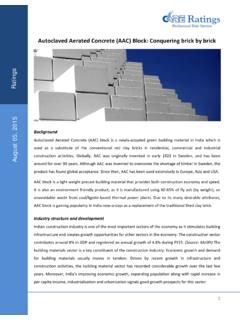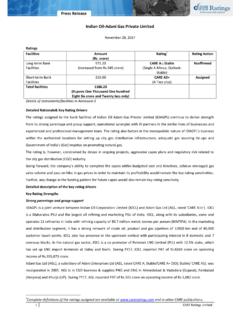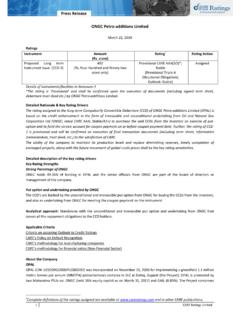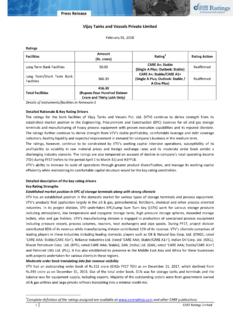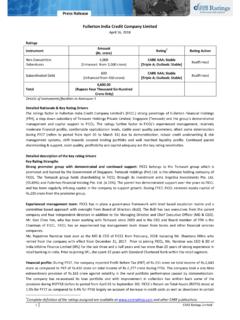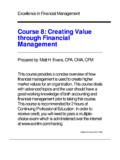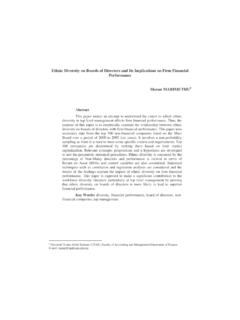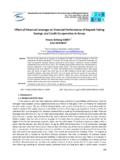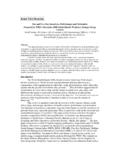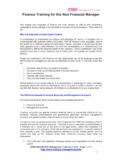Transcription of Financial ratios – Non Financial Sector - …
1 1 Financial ratios Non- Financial Sector Background Financial ratios are used by CARE to make a holistic assessment of Financial performance of the entity, and also help in evaluating the entity s performance vis- -vis its peers within the industry. Financial ratios are not an end by themselves but a means to understanding the fundamentals of an entity. This document gives a general list of the ratios used by CARE in its credit risk assessment. In addition to the ratios mentioned in this document, various other Sector -specific ratios are used by CARE for evaluating entities in that Sector . The common ratios used by CARE can be categorised into the following five types: Growth ratios Profitability ratios Leverage and Coverage ratios Turnover ratios Liquidity ratios These are given in detail below: Financial ratios NON Financial Sector Financial ratios Non- Financial Sector 2 A.
2 Growth ratios Trends in the growth rates of an entity vis- -vis the industry reflect the entity s ability to sustain its market share, profitability and operating efficiency. In this regard, focus is drawn to growth in income, PBILDT, PAT and assets. The growth ratios considered by CARE include the following ( t refers to the current period while t-1 refers to the immediately preceding period): Ratio Formula Growth in Net Sales [(Net Salest 12 / No. of Months) (Net Salest-1 12 / No. of Months)] 100 [Net Salest-1 12 / No. of Months] Growth in Total Operating Income [(TOI t 12 / No. of Months) (TOI t-1 12 / No. of Months)] 100 [TOIt-1 12 / No. of Months] TOI = Total Operating Income Growth in PBILDT [(PBILDTt 12 / No. of Months) (PBILDTt-1 12 / No. of Months)] 100 [PBILDTt-1 12 / No.]
3 Of Months] Growth in PAT [(PAT t 12 / No. of Months) (PAT t-1 12 / No. of Months)] 100 [PATt-1 12 / No. of Months] Total Operating Income- In computing the Total Operating Income (TOI), CARE considers all operating income of the entity. For arriving at the core sales figure, the indirect taxes incurred by the entity (like excise duty, sales tax, service tax etc.) are netted off against the gross sales. CARE also includes some other income related to the core operations like income derived from job work done by the entity, any royalty/ technical knowhow/ commission received in relation to the core operations, refund of indirect taxes, sale of scrap, cash discounts received, duty drawback and other export incentives received by the entity, exchange rate gains (not related to debt).
4 Apart from the income from core operations, CARE also includes non-core income items in the computation of the TOI if the same are recurring in nature there is a consistent trend Financial ratios Non- Financial Sector 3 in the entity deriving income from these sources. Examples include interest income, dividend income, rental income etc. PBILDT- To arrive at the PBILDT, all operating expenses are deducted from TOI. Operating expenses include raw material cost, stores & spares, power and fuel, employee costs, selling and distribution expenses and administrative and general expenses, and includes lease rental, royalty/ technical knowhow/ commission incurred, insurance cost, directors fees, exchange rate loss (not related to debt), bad debts etc. PAT- PAT is arrived at by deducting (-) /adding (+) the following from PBILDT: (-) interest and finance charges net of interest cost which has been capitalized- This includes all finance charges incurred by the entity including interest on term loans, interest on working capital borrowings, interest on unsecured loans from promoters, premium on redemption of bonds, exchange rate profit/loss on debt etc.
5 (-) depreciation/amortization on assets (-) Lease rentals (+/-) non-operating income/expense (including profit/loss on sale of assets and investments) (+/-) prior period items (-) tax expense Gross Cash Accruals (GCA) - GCA is computed by adding all non-cash expenditure (like depreciation, provision for deferred tax) to PAT. Financial ratios Non- Financial Sector 4 B. Profitability ratios Capability of an entity to earn profits determines its position in the value chain. Profitability reflects the final result of business operations. Important measures of profitability are PBILDT margin, PAT margin, ROCE and RONW. Profitability ratios are not regarded in isolation but are seen in conjunction with the peers and the industry segments in which the entity operates.
6 The profitability ratios considered by CARE include: Ratio Formula Significance in analysis PBILDT Margin PBILDT TOI 100 A key indicator of profitability in any manufacturing/service activity without considering the financing mix and the tax expenditure of the entity. PAT Margin PAT TOI 100 Considers both business risk and the Financial risk. This is the margin available to service the equity shareholders. ROCE [PBIT + Non-Operating Income +/- Extraordinary Income/Expenses] [12 / No. of Months] Avg.(TCEt , TCEt-1) 100 ROCE reflects the earnings capacity of the assets deployed, ignoring taxation and financing mix. It is a powerful tool for comparison of performance of companies within an industry. TCE = Total Capital Employed = Networth + Total debt (OR) Net fixed assets + Net Working Capital RONW PAT [12 / No.]
7 Of Months] Avg.(Tangible Networtht , Tangible Networtht-1) 100 RONW reflects the return to equity shareholders. Tangible Networth of the entity includes the equity share capital, all reserves and surplus (excluding revaluation reserve), unsecured loans from promoters which are subordinated to the outside loans, equity share warrants, share application money, ESOPs outstanding, minority interest (in case of consolidated financials). Financial ratios Non- Financial Sector 5 Miscellaneous expenditure not written off and Accumulated Losses- Both Miscellaneous expenditure not written off and Accumulated Losses are deducted from the above to arrive at the tangible networth. Revaluation Reserves- Revaluation reserves arise out of revaluation of fixed assets and are not treated as a part of the tangible networth of the entity.
8 Treatment of intangible assets- An intangible asset is an asset which is not physical in nature. Examples of intangible assets include computer software, patents, copyrights, licenses, intellectual property, trademark (including brands and publishing titles), customer lists, mortgage servicing rights, import quotas, franchises, customer or supplier relationships, customer loyalty, market share, marketing rights, goodwill etc. Generally intangible assets are excluded from the tangible networth of the entity ( software, internally generated goodwill, goodwill on consolidation). However, in case the intangible asset is critical to the core operations of the entity, CARE considers the same as a part of the tangible networth of the entity.
9 Examples include: Telecom license fees paid by the telecom operators to the Government of India Surface rights paid by the miners to undertake mining activity in India Media rights like movie rights, audio rights, video rights, broadcasting rights, television rights, theatrical rights, satellite rights, music rights, digital rights, overseas rights, copyrights etc. Intellectual Property Rights (IPRs) - Intellectual Property is a non-physical property created by the intellect of the human mind. Examples of Intellectual Property include patents, copyrights, trademarks, designs etc. IPRs are generally seen in the IT and pharmaceutical sectors. Purchased Goodwill/ goodwill arising on amalgamation Treatment of Deferred Tax Liability (DTL)- DTL is the timing difference between the accounting profit and profit as per income tax act.
10 As this difference is expected to reverse in the future, CARE excludes the same from the computation of the tangible networth of the entity. Financial ratios Non- Financial Sector 6 C. Leverage and Coverage ratios Financial leverage refers to the use of debt finance. While leverage ratios help in assessing the risk arising from the use of debt capital, coverage ratios show the relationship between debt servicing commitments and the cash flow sources available for meeting these obligations. CARE uses ratios like Debt-Equity Ratio, Overall gearing ratio, Interest Coverage, Debt as a proportion of cash accruals and Debt Service Coverage Ratio to measure the degree of leverage used vis- -vis level of coverage available with the entity for debt servicing.

